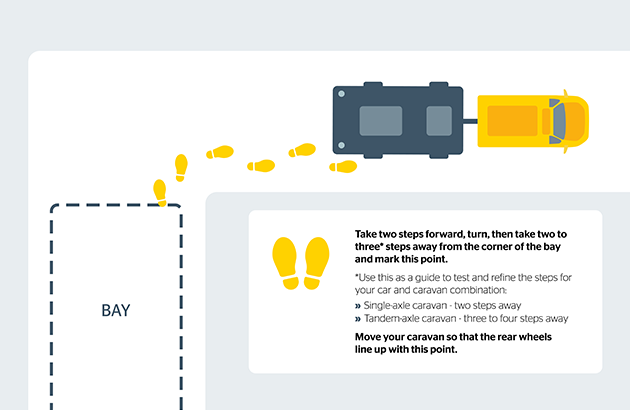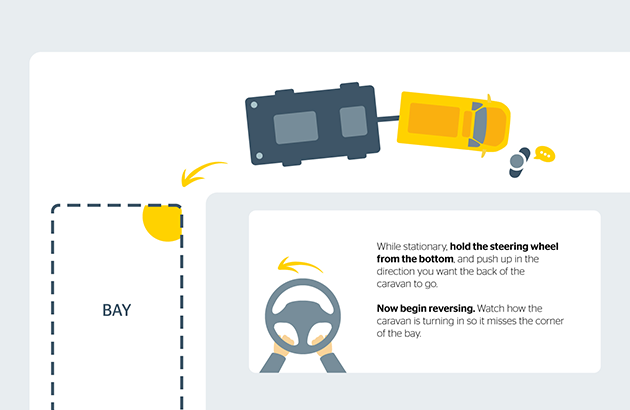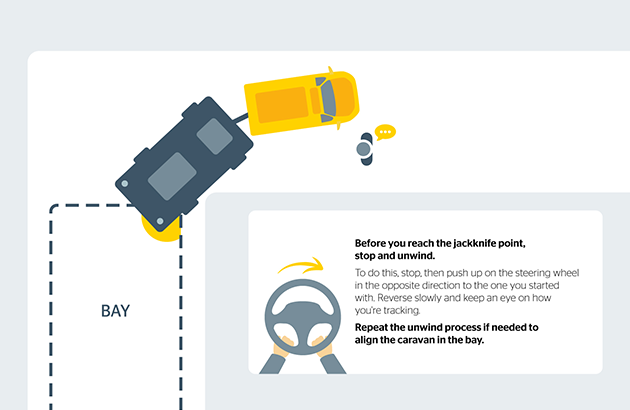How to Reverse A Caravan Safely | A Step-by-Step Guide

Reversing a caravan is one of the more challenging RV ownership skills, especially for new caravan owners. While having a good sense of direction is always helpful, manoeuvring a large, heavy and ungainly vehicle can be difficult, particularly if parking in a tight space. But it’s a vital skill that, with practice, you can easily master! Here is our step-by-step guide on how to reverse a caravan into a driveway, reversing a caravan into a site, and securing your caravan once it’s parked.
Reversing a caravan - general rules
When reversing a caravan, it's always easier to reverse to the driver's side, so if possible, take this approach. You should make all steering adjustments while stationary — stop, adjust, check (come to a halt), make any adjustments, and then move slightly. Most importantly, take it slow, because the faster you go, the more likely you will get into logistical trouble! Also, if you have bikes stored at the front of your caravan on a rack, take them off before you start as they can cut down your turning angle when you’re reversing.
How to reverse a caravan - a step-by-step guide
This guide covers reversing a caravan into a site and a driveway — the principles are pretty much the same. Regarding other locations (like campgrounds and beaches), you will need to be aware of surrounding obstacles (like trees). You should also consider the tyre pressure of your vehicle and caravan if driving in certain conditions.
Step #1 - Choose your spotter
A spotter is a person you trust to give guidance and directions on how to manoeuvre your caravan safely, efficiently and effectively. When you’re ready to reverse, they should stand at the front of the vehicle (never behind!) so they can see where the caravan is going and what it will do.
Step #2 - Agree on hand signals
Clear and open communication is critical so there’s no confusion. As the driver, hold your hands at the bottom of the steering wheel. All steering movements should be made while the vehicle is stationary, and will be either full lock to the left, full lock to the right, or straight wheels. All you need to do then is adjust how far you move. Recommended hand signals are:
| Action | Directions |
|---|---|
| Move the back of the caravan in a specific direction. |
|
| Signal straight wheels. |
|
| Help position the wheels straight. |
|
| Signal to stop. |
|
| Signal to reverse. |
|
| Signal to come forward. |
|
Step #3 - Check your location
When you arrive, hop out and inspect your surroundings. Look for obstacles and anything that you're likely to run over. If you’re staying somewhere with a campsite power outlet, check where it’s located. Leave enough room for your awning or annex if you have one and a bit of extra space for when you step outside. Some caravan parks have a concrete slab, so you’ll want to reverse in as close to this slab as possible so you don’t have to jump from your step to the slab!
Step #4 - Mark your turn-in point
When reversing a caravan, the turn-in point measures where your caravan's rear wheels should be, as this is the pivot point from which it will start to turn. Every vehicle and caravan combination is different, and each will turn in at a different rate. Hence, it’s essential to identify the turn-in point for your caravan, as this will make it easier to park safely and accurately.
First, identify the corner of the designated spot that you're reversing into. You don't want to be too close to the side of this, so we recommend being at least two paces out. Use this as a starting point and refine it from there:
- For a single-axle caravan, take two steps away from the corner of the designated spot and mark this point.
- For a tandem-axle caravan, take three steps away from the corner of the designated spot and mark this point.
This is where you need to start to turn the caravan in, so move your caravan so that the rear wheels line up with this point.
When you go to reverse, if you find the caravan cuts into the corner, take one less step so that it turns in a little later and misses the corner. If you find that it turns in and ends up in the middle of the parking spot, take an extra step away from the corner so that it brings your turn-in point earlier and will move it closer to the side of the parking spot.

Source: RAC
Step #5 - Reversing into the space
If you are the driver when reversing a caravan, push up on the steering wheel in the direction that the spotter is pointing. The spotter should check that the front wheels are pointing in the opposite direction to which they are pointing. Once you are happy with the steering direction, the spotter will motion for you to start moving backwards and the caravan will start turning in the pointed direction into the parking spot.
If it turns in too quickly, the spotter should signal to stop and change the wheel direction to straight wheels. This will slow the turn rate but still turn the caravan into the location. The spotter should again signal you to go backwards, watching how the caravan turns and stopping the vehicle before it jackknifes.

Source: RAC
Reaching the jackknife point
One thing we want to avoid when caravan reversing is reversing while the caravan is in a jackknife position. A jackknife occurs when we start turning the caravan into the location, and the back of the vehicle comes into contact with the front of the caravan and causes damage to either or both.
To manage this from a spotter's perspective, while standing at the front of the vehicle, look straight down the side of the vehicle and identify a particular feature on the front of the caravan that appears before the point of jackknifing. You should signal the drive to stop when that feature comes into view.
From the driver's perspective, look in the vehicle wing mirror straight down the side of the car. Once the back of the car lines up with the feature you've identified for your vehicle and caravan combination, stop. The spotter should now point in the opposite direction to the one that has been originally indicated. The driver will push up on the steering wheel in the opposite direction to the one you started with. Reverse slowly, and repeat the unwind process if needed to align the caravan correctly.
Once the caravan is positioned, the spotter should walk to the back of the caravan to work out how far back to go. Pace the distance out and then return to the driver's door. They should pace this distance out from the driver's door towards the caravan, stand still and tell the driver to reverse back until they are level with the spotter. If you're solo, pace the distance out yourself and place a mark on the ground. Reverse until your driving position is level with that mark.

Source: RAC
Fixing suspension twist on a tandem-axle caravan
When turning a tandem axle caravan around a corner, each wheel travels a different distance, causing a significant twist in the suspension. That twist is projected into the subframe of the caravan and through to your tow hitch. The force against your tow hitch can make it very difficult to remove. A simple fix is to drive forward and back again to remove the twist once you have the caravan in position.
Step #6 - Securing your caravan
Once your caravan is parked, you should ensure that it is secure. Caravan levellers are the ideal solution, and there are a few options to choose from depending on your van’s tyre width, weight, and whether it’s a single or tandem-axle caravan. These include chocks and ramps (or a combination of both).
For expert advice on how to reverse your caravan safely and efficiently, contact your local dealership today.